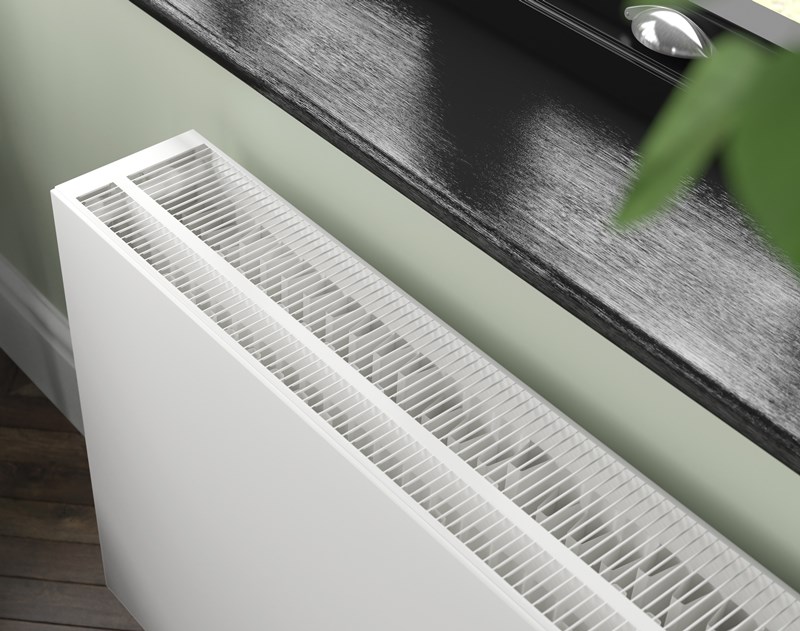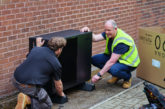
With the number of heat pumps being installed on the rise, Chris Harvey, Head of Marketing, Stelrad Radiators Limited, looks at how radiators can work with low temperature heating systems.
Radiators have been around for well over a century in some forms, but the radiators of today are a very different beast to their predecessors and offer an efficient, straightforward and proven way of sharing heat effectively around homes up and down the UK and Ireland.
Radiators still provide the heat sharing skills in around 90% of all homes in the country and need to be sized properly to provide comfort heating. Appropriately sized radiators will work well with heat pumps if insulation levels are appropriate and, depending on the home, larger radiators are installed or K3 design radiators are specified to provide the additional metal surface areas required to provide the levels of heat needed to keep homes cosy.
Genuine rethink
The advent of low temperature heating systems in response to the need to decarbonise domestic heating systems across the UK is seeing the first genuine rethink in heating for many decades. Despite the desire of many in the sector to fight against the loss of the traditional fossil fuelled boilers that have been the mainstay of the heating industry for years and years, heat pumps are making significant headway.
The change is coming, and the farewell wave to boilers in new build properties from 2025 will inevitably be followed by a drive – driven probably by legislation of some sort – to switch to renewable heating in existing properties within a few years and almost certainly by 2035.
Gaining ground
The UK heating industry – in the form of its installers at any rate – is making the decision to welcome heat pump technology with open arms with recent independent research highlighting that as many as 70% of all installers in the UK are looking to be trained to install heat pumps in 2023 – up from just 19% this time last year.
Installers operating at the sharp end of the industry are adopting the sensible approach that with heat pumps clearly being encouraged by the Government, increasingly being accepted by the new homes sector and offering a very clear option for replacement heating systems, it’s clear that heat pumps – in particular air to water heat pumps – are gaining significant ground when it comes to acceptance as the key technology for renewable heating and hot water in the UK.
More sizes
The rise of the heat pump is seeing the need for larger and higher capacity radiators. Stelrad has responded to these needs by broadening its already massive range of sizes and shapes for its most popular radiators and the introduction of a wider range of vertical radiators. It is also meeting the enhanced need for its K3 radiators – with three panels and three fins offering 50% more heating capacity from a radiator with the same footprint as a K2 format radiator for example.
Stelrad continues to mount its ‘Fit for the Future’ campaign, highlighting that radiators are very much able to provide the levels of comfort heating and hot water required in UK homes, when paired with heat pumps.
The arrival of the new upgrade to Building Regulations brings with it a realisation that the key figure to bear in mind is 55°C – the maximum flow temperature for all new wet heating systems from this date.
Understandable questions
The arrival of the low temperature heating system has brought with it perhaps understandable questions that installers and specifiers want answers to. Can we still use products we use now with traditional boiler driven heating systems if the heat source is a heat pump? Is there anything we need to consider that we take for granted nowadays?
The answer is of course yes – we need to look closely at how to ensure that the heat generated is shared effectively in the new home or the existing home that is having its heating system upgraded.
Sizing calculator
In new build housing, using a heat pump-based solution is a relatively simple solution. The heating system can be designed into the home at the outset so you know the parameters in which the heating system has to operate – the method of construction, the size of the rooms, the number, type and size of doors and windows – so the heat loss calculations can be done up front and radiators sized accordingly. The levels of insulation can be agreed at the outset that will provide the best support for any heating system chosen, whether radiators or underfloor heating.
The key to radiators operating well in any situation is to size them properly at the outset, which involves accurately working out heat loss calculations to achieve the necessary number of BTUs required to provide comfort heating in each room and to select a radiator that can provide that level of heating.
Stelrad offers a simple to use and free radiator sizing and heat loss calculator along with a Renewables Advice page on its website. Facts and helpful information are also shared through a free to take CPD also available on its website.
Radiators are very much ‘fit for the future’ but as always, correct sizing will need to be undertaken to ensure that they keep the home warm and cosy. But can radiators work well with air source heat pumps? Very definitely yes, they can – and they already are in a host of installations across the UK.













